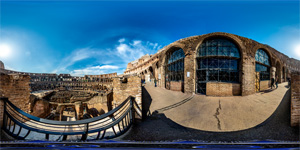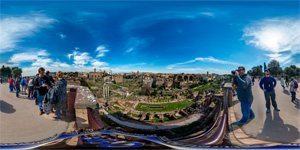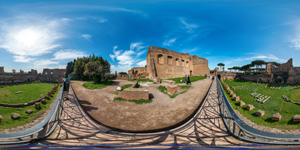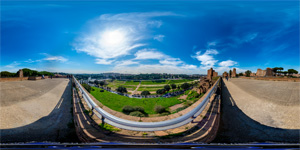
|
 View mobile version View mobile version
Virtual Tours and Panoramic images.
Click on "Fullscreen" under each image to see high resolution panoramas or
|
|
|
|
|
|
|
|
| Colosseum & Forum Romanum
The Colosseum or Coliseum, also known as the Flavian Amphitheatre or Colosseo, is an oval amphitheatre in the centre of the city of Rome, Italy. Built of travertine limestone, tuff (volcanic rock), and brick-faced concrete, it was the largest amphitheatre ever built at the time
The Roman Forum, also known by its Latin name Forum Romanum, is a rectangular forum (plaza) surrounded by the ruins of several important ancient government buildings at the center of the city of Rome.
The Palatine Hill, which is the centremost of the Seven Hills of Rome, is one of the most ancient parts of the city and has been called "the first nucleus of the Roman Empire." From the time of Augustus Imperial palaces were built here.
| |
Currently 13 panoramas in this collection
|
|
Colosseum
The Colosseum or Coliseum, also known as the Flavian Amphitheatre or Colosseo, is an oval amphitheatre in the centre of the city of Rome, Italy. Built of travertine limestone, tuff (volcanic rock), and brick-faced concrete, it was the largest amphitheatre ever built at the time and held 50,000 to 80,000 spectators. Construction began AD 72 and was completed in AD 80. Further modifications were made (81–96). it was used for gladiatorial contests and public spectacles such as mock sea battles, animal hunts, executions, re-enactments of famous battles, and dramas based on Classical mythology. Also seen in this panorama: Arch of Constantine the Great.
2017-03-13
Show on map
|

Colosseum
Fullscreen
|
|
Colosseum's Usage
The Colosseum was used to host gladiatorial shows as well as a variety of other events. The shows, called munera, were always given by private individuals rather than the state. They had a strong religious element but were also demonstrations of power and family prestige, and were immensely popular with the population. Another popular type of show was the animal hunt, or venatio. This utilized a great variety of wild beasts, mainly imported from Africa and the Middle East, and included creatures such as rhinoceros, hippopotamuses, elephants, giraffes, aurochs, wisents, Barbary lions, panthers, leopards, bears, Caspian tigers, crocodiles and ostriches.
2017-03-13
Show on map
|

Colosseum's Usage
Fullscreen
|
|
Colosseum Today
Although substantially ruined because of earthquakes and stone-robbers, the Colosseum is still an iconic symbol of Imperial Rome and is listed as one of the New 7 Wonders of the World. It is one of Rome's most popular tourist attractions and also has links to the Roman Catholic Church, as each Good Friday the Pope leads a torchlit "Way of the Cross" procession that starts in the area around the Colosseum. In 2018, it was the most popular tourist attraction in the world, with 7.4 million visitors.
2017-03-13
Show on map
|

Colosseum Today
Fullscreen
|
|
Colosseum's name
The Colosseum's original Latin name was Amphitheatrum Flavium, often anglicized as Flavian Amphitheatre. The building was constructed by emperors of the Flavian dynasty, following the reign of Nero. The name Colosseum is believed to be derived from a colossal statue of Nero that once stood nearby. It was then commonly referred to as the "Colossus solis" or only "Colossus". The Colossus did eventually fall but the year 1000 the name "Colosseum" had been coined to refer to the amphitheatre.
2017-03-13
Show on map
|

Colosseum's name
Fullscreen
|
|
Interior seating in Colosseum
Special boxes were provided at the north and south ends respectively for the Emperor and the Vestal Virgins, providing the best views of the arena. Flanking them at the same level was a broad platform or podium for the senatorial class, who were allowed to bring their own chairs. The tier above the senators, known as the maenianum primum, was occupied by the non-senatorial noble class or knights (equites). The next level up, the maenianum secundum, was originally reserved for ordinary Roman citizens (plebeians) and was divided into two sections. The lower part (the immum) was for wealthy citizens, while the upper part (the summum) was for poor citizens.
2017-03-13
Show on map
|

Interior seating in Colosseum
Fullscreen
|
|
Forum Romanum Overview
The Roman Forum, also known by its Latin name Forum Romanum, is a rectangular forum (plaza) surrounded by the ruins of several important ancient government buildings at the center of the city of Rome. Citizens of the ancient city referred to this space, originally a marketplace, as the Forum Magnum, or simply the Forum. For centuries the Forum was the center of day-to-day life in Rome: the site of triumphal processions and elections; the venue for public speeches, criminal trials, and gladiatorial matches; and the nucleus of commercial affairs. Here statues and monuments commemorated the city's great men.
2017-03-13
Show on map
|

Forum Romanum Overview
Fullscreen
|
|
Arch of Septimus Severus
The Arch of Septimius Severus at the northwest end of the Roman Forum is a white marble triumphal arch dedicated in 203 to commemorate the Parthian victories of Emperor Septimius Severus and his two sons, Caracalla and Geta, in the two campaigns against the Parthians of Persia in 194/195 and 197-199. In this panorama also can be seen: Churc Santi Luca e Martina, Column of Phocasand remains of: Temple of Castor and Pollux, Temple of Saturn and Temple of Vespasianus.
2017-03-13
Show on map
|

Arch of Septimus Severus
Fullscreen
|
|
Domus Tiberianus
Domus Tiberiana was an imperial palace on the Palatine of Rome. The palace was started by Emperor Tiberius and enlarged by Nero. Cryptoporticus runs along its entire eastern side. Domus Tiberiana does not normally appear to have been used by the emperor himself, but was disposed of by the successor to the throne. In this panorama can also be seen: remains of Temple of Castor and Polllux, Temple of Antoninus and Faustina, courtyard of house of Vestals and Basilica Maxentius.
2017-03-13
Show on map
|

Domus Tiberianus
Fullscreen
|
|
Antoninus and Faustina Temple
The Temple of Antoninus and Faustina is an ancient Roman temple in Rome, which was later converted into a Roman Catholic church, the Chiesa di San Lorenzo in Miranda. It is located in the Forum Romanum, on the Via Sacra, opposite the Regia. The temple was constructed by the Emperor Antoninus Pius, beginning in 141 AD. It was initially dedicated to his deceased and deified wife, Faustina the Elder. Because of this, Faustina was the first Roman empress with a permanent presence in the Forum Romanum. When Antoninus Pius was deified after his death in 161 AD, the temple was re-dedicated to both Antoninus and Faustina by his successor, Marcus Aurelius. Also seen in this panorama: Remains of "Temple of Castor and Pollux" and "Temple of Vesta".
2017-03-13
Show on map
|

Antoninus and Faustina Temple
Fullscreen
|
|
House of the Vestals
The House of the Vestal Virgins was the residence of Vestal Virgins, located behind the circular Temple of Vesta at the eastern edge of the Roman Forum, between the Regia and the Palatine Hill. The Atrium Vestae was a three-story 50-room palace in the ancient Roman Forum built around an elegant elongated atrium or court with a double pool. To the very east is an open vaulted hall with a statue of Numa Pompilius, the mythological founder of the cult. Also seen in this panorama: "Temple of Castor and Pollux" and "Temple of Antoninus and Faustina"
2017-03-13
Show on map
|

House of the Vestals
Fullscreen
|
|
Column of Phocas
The Column of Phocas (Colonna di Foca) is a Roman monumental column in the Roman Forum of Rome, Italy. Erected in front of the Rostra and dedicated or rededicated in honour of the Eastern Roman Emperor Phocas on August 1, 608, it was the last addition made to the Forum Romanum. The fluted Corinthian column stands 13.6 m (44 ft) tall on its cubical white marble socle. The monument remains today in its original location (in situ). Its isolated, free-standing position among the ruins has always made it a landmark in the Forum. Also seen in the panorama: Arch of Septimus Severus, remains of Temple of Saturn, Temple of Vespasianus.
2017-03-13
Show on map
|

Column of Phocas
Fullscreen
|
|
Stadium
It is still uncertain the precise function of this large building, also known as Domitian's stadium (Stadio di Domiziano) or "Circus Agonalis". The stadium was part of the imperial palace and was surrounded by a two-story portico. Maybe it was not just an hippodrome, but more in general, it was the "viridarium" (the garden), private place where the emperor he could walk on sunny days and watch the races.
2017-03-13
Show on map
|

Stadium
Fullscreen
|
|
Circus Maximus
The Circus Maximus (Latin for greatest or largest circus; Italian: Circo Massimo) is an ancient Roman chariot-racing stadium and mass entertainment venue located in Rome, Italy. Situated in the valley between the Aventine and Palatine hills, it was the first and largest stadium in ancient Rome and its later Empire. It measured 621 m (2,037 ft) in length and 118 m (387 ft) in width and could accommodate over 150,000 spectators.[1] In its fully developed form, it became the model for circuses throughout the Roman Empire. The site is now a public park.
2017-03-13
Show on map
|

Circus Maximus
Fullscreen
|
|











